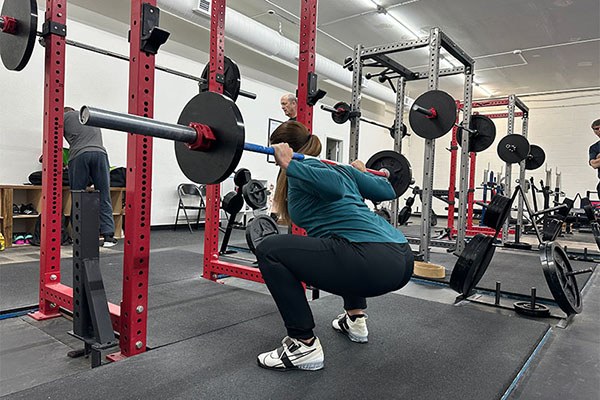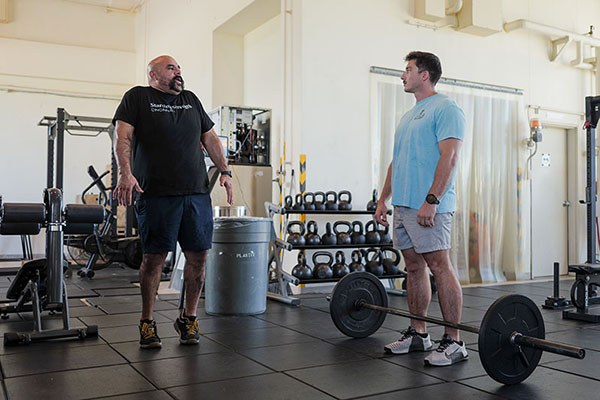August 05, 2024
Anamnesis Edition
On Starting Strength
-
At the Movies with Rip –
Rip talks about movies live with Starting Strength Network subscribers and fans. -
Are You Training Effectively For Your Sport? Part 2 by Chris Olson –
In Part 1, we discussed sport-specific conditioning. We continue here by looking at the importance of sport-specific skill and strength, and then begin a discussion… -
Finish Your Deadlift: The Last Five Percent –
Rip explains the steps to achieve a proper deadlift lockout, making sure you complete the movement instead of stopping short. The correct finish involves lifting your chest and pulling your shoulders back. Not doing so means you’re only completing 95% of the rep. -
The Clear Path by Jim Steel –
I see a rather large divide in the training world today. You don’t have to be brilliant to notice it, it’s rather obvious… -
How to Warmup for Barbell Training –
Grant Broggi, Starting Strength Coach and owner of The Strength Co, shows you how to do a proper warmup for the basic barbell lifts. - Weekend Archives:
Pro Tip on Step Three of the Deadlift Setup –
Starting Strength Coach Steve Ross demonstrates a drill to use if you’re having trouble keeping your back set on the deadlift. - Weekend Archives:
Women in Ground Combat by Mark Rippetoe –
It is fashionable these days to appear concerned about what is currently interpreted as “inequality.” Inequality can be accurately defined as…
In the Trenches

60 year old Alan, who drove 12 hours from Strasburg, Colorado, gets set to pull the first rep of his work set of five at the Squat and Deadlift Camp in coached by Sam Krapf in Twin Falls, Idaho. [photo courtesy of Ashley Montgomery]

Krista, from Kennewick, Washington, working on the correct bottom position during her first warm up set of squats at the Squat and Deadlift Camp held at Ground Zero Strength in Twin Falls, Idaho. [photo courtesy of Ashley Montgomery]

Will Morris, SSC lectures during the squat portion of the Squat and Deadlift Camp held at Starting Strength Tulsa in Tulsa, OK last weekend. [photo courtesy of Caleb Rivera]

Starting Strength Coach Shaun Pang works with members of the 18th Explosive Ordinance Disposal Flight at Kadena Air Base in Okinawa, Japan as they learn the how and why of integrating barbell training into their physical preparedness. [photo courtesy of Nick Delgadillo]

Starting Strength Coach Nick Delgadillo discusses the shrug at the top of the power clean during a workshop with the 18th EOD Flight at Kadena Air Base in Okinawa, Japan. Working with Air Force EOD presents a unique opportunity as each individual airman is responsible for his own training and meeting PT standards. [photo courtesy of Shaun Pang]

Will Abbott squats 230 at Starting Strength Atlanta, while apprentice coach Isabelle Garay watches back angle, knee position, and depth. Will is the goalie for his high school’s water polo team (no, their feet don’t reach the bottom of the pool; they have to tread water). Isabelle’s 270 bench was good enough to place in a recent national meet, second only to the well known Jen Thompson. [photo courtesy of Adam Martin]

A few weeks before he begins his freshman year of high school, Jacob squats 135 lb for sets of five. Jacob trains with his dad, Scott, at Testify Strength & Conditioning in Omaha, NE. [photo courtesy of Phil Meggers]

At the 2024 Starting Strength Gyms conference in July, Starting Strength Atlanta was awarded the distinction of Fastest Growing Gym, for demonstrating the fastest growth over the time that it has been open. Still, even at this busy 6:00 a.m. M-W-F session, a platform is reserved for all scheduled trainees, and nobody will ask them, “How many sets you got left?”, and then stare daggers while they wait. [photo courtesy of Adam Martin]

Starting Strength Cincinnati owner Luke Schroeder presents member Yasmen Brown-Jones with the 2024 Stronger is Better Award. This national award is given to the Starting Strength Gyms member that best represents our “Stronger is Better” ethos. Congratulations Yaz! [photo courtesy of West Chester Liberty Chamber Alliance]
Get Involved
Best of the Week
Shoulder rehab case study
george_97
I’m a 27-year-old lad from Sweden. I’ve watched your video on YouTube titled “Shoulder Case Study” several times, and I’m trying to understand why you include lat pulldowns as an exercise to rehab a shoulder injury. What I did understand from your anatomy lesson is that the top of the military press is in agreement with the rotator cuff’s natural biomechanical role, which is compressing the top of the humerus against the glenoid and acting as a dynamic stabilizer. Another dynamic stabilizer for the shoulder joint is the long head of the biceps brachii. Is that the reason you include the lat pulldown? Because the biceps is a dynamic stabilizer for the shoulder? Or because it’s rotating the scapula in the opposite direction?
Mark Rippetoe
What is the latissimus dorsi action on the shoulder?
george_97
The latissimus dorsi attaches anteriorly on the humerus and is active in the extension of the humerus. It also adducts and rotates the humerus ? I know if the lats become tight they internally rotate the shoulder. I’m trying to think why you asked me that question sir but my intuition is not kicking in. I don’t understand. I don’t understand the intuitive interplay between shoulder rehab and the function of the lats .. Help me understand sir.
george_97
Alright I think I get it now we need to strengthen the shoulder in its respective directions i.e. Flexion, extension, abduction, adduction + the collective function of the rotator cuff. In a military press we get the rotator cuff function + abduction, flexion. Left is adduction and extension, which you include in a lat pulldown and later chins + we get the biceps involved as well which is also a dynamic stabilizer for the shoulder. Am I overcomplicating things or on the right track Sir?
Mark Rippetoe
You’ve got it. The shoulder is arguably the most geometrically and anatomically complex articulation in the body, and all its functions must be employed in the rehab.
Best of the Forum
RPE Templates
Eric Larousse
How do people that sell these templates manage to stay in business being that their programs are complete BS and do not work?
Mark Rippetoe
Do you remember the Pet Rock?
SouthernLifter
I think their business is selling to people who are afraid of big weights.
I’ve seen, for example, a relatively light man (I don’t know, maybe 70kg) reach an “RPE 8” by doing 60kg squats and things like that.
I don’t know exactly the whole theory of this, but RPE 8 would be like you’re pushing yourself pretty hard, or so I think, and you’re feeling pain.
RPE 9 or 10 maybe it would be 70 or 75 kg??? Don’t know.
I have seen some of those videos and I have laughed. A nutritionist and “””””trainer””””” from my community trains people with that. Obviously, they’re also big promoters of kettlebells, bands, jumping rope and all that crap.
The man lifting those 60 or 70 kg is the most “powerful” thing you will see in that “gym”.
Of course, she and her accomplice say they are “strength trainers.”
What assholes…
Andrew Lewis
I think it’s probably two parts. The first part is the novice effect. Any program will work if you are unadapted and put in effort. A lot of people have gotten strong doing less than optimal program just by working their asses off. The second part is that you can blame the lifter for not using it right if it’s not working: “well you just don’t know how to use RPE right. You implemented it incorrectly.”






